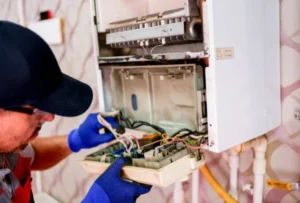Did you know that dirty AC coils can reduce your HVAC system’s efficiency by up to 30%, leading to higher energy bills and costly repairs? Imagine your AC struggling to cool your home on the hottest day of the year all because of dirty coils.
Cleaning your AC coils is one of the most effective ways to maintain your system’s performance, save money, and extend its lifespan. In this guide, we’ll walk you through the step-by-step process of cleaning both evaporator and condenser coils, along with essential tips, and maintenance advice.
What Are AC Coils?
AC coils are important parts of your heating and cooling system that help in cooling the air by transferring heat. There are two types of coils:
- Evaporator Coils: Located inside your home, these coils absorb heat from the air, cooling it before it’s circulated back into your living space.
- Condenser Coils: Located outside, these coils release the absorbed heat into the environment.
Both coils work together in the refrigeration cycle to transfer heat, ensuring your AC system cools your space effectively. Regular maintenance, such as cleaning the coils and checking for refrigerant leaks, helps maintain efficiency and prolongs the system’s lifespan.
Read More: Does AC and Furnace Work Together? Find Real Connection!
Problems From Dirty AC Coils
If you want your AC to work well, you need to take care of it. When the coils inside get dirty, the unit has to use more energy to perform at the same level. This means your bills will be higher because your fan will have to run all the time to keep your house cool. But even then, it won’t work efficiently.
I once ignored my air conditioner maintenance for a year, thinking it would be fine. But eventually, I noticed that my house wasn’t staying as cool as before. Then, one day, the system stopped working entirely. The coils had become so dirty that they froze, leading to a complete breakdown. The repair was costly, and I had no choice but to consider a replacement.
To avoid such a situation, it’s important to keep both the condenser and evaporator clean. When they are clogged with dust and debris, the AC unit struggles to do its job properly. Otherwise, you may find yourself needing to replace parts, which is not cheap.
To make sure this doesn’t happen, clean the coils at least once a year. It’s a small effort compared to the trouble and expenses that come with a neglected air conditioner.

The Best Way to Clean AC Coils
Keeping your air conditioning system in top shape is essential for efficiency and longevity. One key part of maintenance is cleaning the coils to ensure your unit runs smoothly. If dirt and dust build up, your AC won’t cool properly, leading to higher energy bills and possible breakdowns. Here’s a simple and effective step-by-step guide to clean your AC coils the right way.
Step 1: Disconnect the Power Supply to Your Air Conditioning Unit
Before you do anything, turn off the power to your air conditioning system to prevent accidents. You can do this by switching off the circuit breaker or unplugging the outdoor unit. This step is crucial to avoid electrical hazards while working on your AC.
Step 2: Take Off the External Panel of the Air Conditioning System
Next, take off the outer cover of the air conditioning unit to get access to the coils. This may involve unscrewing a few screws or lifting the cover, depending on your AC model. Make sure you place everything in a safe spot so you can easily put it back later.
Step 3: Clean the Coils and Fins
Now, it’s time to remove the loose dirt and debris from the coils and fins. Use a soft-bristled brush or compressed air to do this gently, ensuring you don’t end up damaging the aluminum fins. Don’t forget to clean both the indoor and outdoor parts of your AC unit for a thorough job.
Step 4: Apply Coil Cleaner
Once the visible dirt is gone, apply a coil cleaner to get rid of stubborn grime. You can either buy a commercial cleaner or make your own by mixing water and vinegar in a spray bottle. Spray the solution evenly over the coils and let it sit for about five to ten minutes to break down stubborn dirt.
Step 5: Rinse the Coils and Fins
After the cleaner has done its job, use a hose to rinse off the coils and fins thoroughly. Be sure to use low pressure to avoid damaging the delicate components. Always rinse from the inside out to ensure that all debris is properly removed.
Step 6: Let the Coils Dry
Once you’re done rinsing, allow the coils to air dry completely before replacing the outer cover and turning power back on to your air conditioning unit. Giving the unit enough time to dry ensures that no moisture remains trapped inside, which could lead to mold growth.
Read More: Clear Your AC Drain Line Today for Peak Performance!
Common Mistakes to Avoid When Cleaning AC Coils
Keeping your air conditioner’s coils clean is essential for maintaining efficiency and preventing costly repairs. However, improper cleaning methods can cause damage and reduce the lifespan of your AC unit. Here are some common mistakes to avoid when cleaning AC coils:
Using the Wrong Cleaning Products
Many homeowners use harsh chemicals or household cleaners that can corrode the coils and damage the protective coating. Always use a manufacturer-recommended coil cleaner or a mild detergent with water.
Skipping Regular Maintenance
Neglecting to clean your AC coils regularly can lead to dirt buildup, reduced efficiency, and increased energy consumption. Make it a habit to check and clean the coils at least once or twice a year.
Using Excessive Water Pressure
A high-pressure hose or power washer can bend the delicate fins on the coils, reducing airflow and affecting performance. Instead, use a low-pressure sprayer or a soft brush to gently remove dirt and debris.
Not Turning Off the Power
Attempting to clean AC coils without turning off the power can be dangerous. Always disconnect the power source before starting any maintenance to avoid electrical hazards.
Neglecting the Fins
The fins on the evaporator and condenser coils can easily become bent, restricting airflow. If they are bent, use a fin comb to straighten them gently.
Failing to Remove Large Debris First
Leaves, dust, and dirt can accumulate around the outdoor condenser unit. Before using any cleaner, manually remove large debris to prevent clogging and improve the cleaning process.
Not Rinsing Thoroughly
Leaving residue from cleaning solutions on the coils can lead to corrosion over time. Make sure to rinse the coils thoroughly with clean water to remove any leftover cleaner.
Ignoring the Air Filter
Dirty air filters contribute to dust accumulation on the coils. Always clean or replace your air filter regularly to ensure efficient airflow and prevent dirt from settling on the coils.
Not Allowing the Coils to Dry Properly
Moisture left on the coils can promote mold and mildew growth. After rinsing, allow the coils to dry completely before turning the unit back on.
Attempting Complex Repairs Without Professional Help
If you notice severe damage or heavy corrosion, it’s best to consult an HVAC professional. DIY repairs on complex components can lead to further damage and expensive repairs.
Read More: AC Evaporator Coil Leak Repair: Quick Fixes You Need Now!
When to Call a Professional
While cleaning the coils of your air conditioning unit is a manageable DIY task for some, it’s not for everyone. If you’re unsure or hesitant, it’s best to contact an HVAC technician. A trained professional will know the best way to clean your specific model without causing damage.
If you’re in Simi Valley and need air conditioning service, the experts at RR Electric, Heating & Air are available to assist you. Regular maintenance by a professional ensures your AC stays in peak condition, preventing costly repairs down the road.
FAQs
Can I Clean My Air Conditioner Coils Myself?
Yes, you can clean your AC coil at home. Use a brush to remove dirt from the grooves and a foaming spray to cover the entire surface. Let the foam work, then comb through with the brush. A light mist from a bottle clears excess residue just don’t let it drip on furnace components. If needed, repeat for best results. Keeping coils clean is necessary for efficiency.
Is Soapy Water Safe for Cleaning?
A homemade mix of mild detergent, dish soap, and water can clean coils safely. For heavy grease or oil, use a non-acidic cleaner, spray, and rinse gently. Avoid harsh chemical or commercial cleaners on the evaporator.
What are the signs of a faulty AC coil?
If warm air is coming from the vents instead of cold, your air conditioner might have a problem. It starts and stops too frequently, struggling to properly cool your home. If the AC won’t turn on at all, or you notice a refrigerant leak near the indoor cooling system, these are clear warning signs. Check the components for dust or ice buildup, as dirty coils can be the root cause of these issues.






